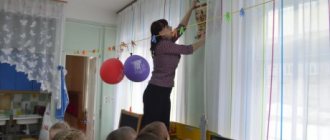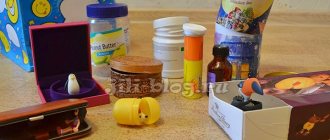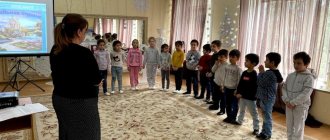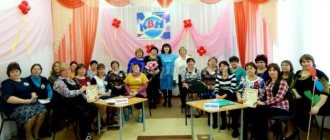Business game as a form of methodological work in preschool educational institutions
Definition 1
Methodological work in a preschool educational institution is an educational activity aimed at teachers mastering methods and techniques for organizing the educational process in a preschool institution and using them in their practice.
This type of activity is aimed at increasing the efficiency and quality of educational services provided by preschool educational institutions. It is associated with the use of measures for the development of each educator, improving his professional skills, expanding and deepening his experience.
The methodological work of preschool educational institutions is based on the use of various methods and means that involve the teacher in active work and the use of a creative approach in their activities.
Are you an expert in this subject area? We invite you to become the author of the Directory Working Conditions
Active methods of methodological work contribute to the creative development of the teacher and the creative direction of his teaching and educational work in preschool educational institutions. They expand the professional skills of a teacher and help overcome passivity in the work of a teacher.
One of the active methods of methodological work is a business game.
Definition 2
A business game is a way of simulating the educational process and its individual aspects, during which the basics of management activities and the organization of educational work are mastered.
Business games allow you to create an image, a model of the educational process of a preschool educational institution and develop effective directions for its implementation, taking into account specific conditions, resource support, and teacher capabilities.
A business game helps:
- Forming the teacher’s experience of activity, which can be used in the real educational process of a preschool educational institution.
- Development of skills for resolving problematic educational situations.
- Developing an active position in the educational process.
- Self-training and self-development for teachers, increasing their professionalism.
- Decision-making in various circumstances and areas of educational work of preschool educational institutions.
Finished works on a similar topic
Course work Outline of methodological work with teachers of preschool educational institutions in the form of a business game 470 ₽ Abstract Outline of methodological work with teachers of preschool educational institutions in the form of a business game 250 ₽ Test paper Outline of methodological work with teachers of preschool educational institutions in the form of a business game 190 ₽
Receive completed work or specialist advice on your educational project Find out the cost
The business game is carried out with preschool teachers on the basis of drawing up a summary of its implementation. It represents a plan for conducting a business game.
Methodological event for teachers of the preschool educational institution “Pedagogical Living Room”
Municipal budgetary preschool educational institution
"Kindergarten No. 16 in Krasnoarmeysk, Saratov Region"
Nomination:
Pedagogical ideas and technologies: preschool education
Pedagogical living room
“We are all different, but we are together”
(summary of a methodological event for kindergarten teachers)
Deputy Head
for educational and educational work:
Gerasimova Irina Vasilievna
Krasnoarmeysk
November 3, 2022
Target:
to help teachers comprehend their inner resource and enrich their professional activities with it, create a comfortable environment in the team, and set up the team for cooperation and interaction.
Tasks
:
- Formation of constructive communication based on respect for the personality of another person
- Stimulating the internal reserves of teachers for effective work
- Help in identifying the causes of existing professional problems
Leading:
Education by its nature is a subject - a subjective process, and no technology can replace the living word of a significant adult; everyone knows that they educate with their own personality.
But for one’s own personality to become a professional “tool”
activity, at least two conditions are required:
1. Study and critically comprehend your personal resource: what kind of content is there, what is necessary and what should not be broadcast to others.
2. Master some techniques for broadcasting your personal content to other people.
And today, I invite you to take part in the work of the pedagogical lounge, the theme of which is “ We are different, but we are together.”
».
Our meeting is for those teachers who are truly ready to comprehend their inner resource and enrich their activities with it.
Our activities are aimed at solving the following tasks:
1. Getting to know yourself and your personal characteristics, which can be considered as an educational resource;
2. Understanding your personal interests and values;
3. Finding ways to realize one’s interests and values in educational work with children.
Game I feel like “This is it!!!”
Type of game: entertainment.
Participants: all participants.
Props: not required.
Progress of the game:
Each participant in a circle shows how he feels at the moment. Everyone else repeats after him.
For example, participant A says, “I feel like this,” and yawns, covering his mouth with his hand. Everyone else repeats this gesture.
It is desirable that everyone can express their mood without repeating previous movements.
Exercise “My portrait in the rays of the autumn sun”
(music)
Teachers are asked to draw a sun on pieces of paper, the rays of which symbolize those qualities and abilities for which they respect and love themselves. Then the personalized piece of paper with the sun is passed around the circle and each participant emphasizes the rays if he agrees that his friend has such qualities, and adds other rays - the qualities that he sees in this person. In the end, the leaves are returned to the authors, and everyone comments on the changes that have occurred to their sun. Some people have significantly more rays. Then it is proposed to read it, but with the pronoun “I”.
Exercise "Walnut"
The leader pours walnuts in the center of the circle and asks everyone to take one for themselves. For some time, you are invited to carefully examine your nut, study its structure, structural features, and try to remember all its individual features.
Then the presenter puts the nuts back into the bag, mixes and again
pours out in the center of the circle. The task of each participant is to find his own nut.
Discussion:
who remembered their nut and what strategy they used to find it later?
At first glance, it seems that all nuts are very similar, but if you spend
time to take a closer look, you will notice that they are different and it is almost impossible to confuse your nut with others. It’s the same with people: they are all very different, memorable, each with their own individual features, “irregularities,” their own beauty and attractiveness. You just need to feel and understand it.
Exercise “Three Colors of Personality”
Each participant receives 3 small leaves of different colors. The presenter explains the meaning of each color.
For example, yellow - like everyone else
blue - like some
pink - like no other.
Each participant is invited to make a note about himself, about his own properties and traits, on pieces of paper of the appropriate color.
At the same time, the quality should be written down on the piece of paper “like everyone else”, in reality
inherent in a given person and uniting him with the seven members of the group.
On the piece of paper “like some” is a quality, property, character or feature of behavior (lifestyle, etc.), which makes it related to some, but not all members of the group.
The last piece of paper should contain indications of the unique features of this participant, which are either not characteristic of the others at all, or are much more pronounced in him.
After filling
The presenter asks all participants to take pieces of paper into their hands, the one on which the traits
“like everyone else” are written down.
The task is to freely communicate with all group members, finding out whether they really have the same feature.
“like some” are discussed in the same way
Everyone must make sure that in the group there are people who have similar characteristics, on the one hand, and that these properties are not inherent in everyone, on the other. If the conditions are not met, you need to write another quality and also subject it to verification.
With leaves “like no one else”
work is organized directly in a circle: each participant voices a quality that he considers his own, unique in this group
In our work it is impossible to completely separate the personal and professional, and if possible, this is unlikely to benefit life and work. There is a lot of professionalism in what and how we tell children, how we react to various situations, what actions we take, and no less - personal characteristics, personal values and passions. Studying your personal characteristics is a powerful resource for professional development, because we learn to build our activities and our communication with students, making maximum use of our personal strengths and capabilities
Exercise "Presentation"
Props: sheets of paper, pens, a sheet of Whatman paper, colored pencils. Leading. Presentation (translated from Latin) means “presentation”. Our kindergarten also needs an introduction. What do we know about him? Year of creation? What is different about the area where our kindergarten is located? What are the attractions? What makes our kindergarten different from others? You have 15 minutes, let's try to compose an ode to our kindergarten. Let's all draw an advertising poster for our kindergarten on a piece of Whatman paper.
Game: Save the egg!
Type of game: rallying.
Composition of participants: groups.
Props: for each group.
Set: 1 raw egg, 3 balloons, 4 A4 sheets, 1.5 meters of thread, 30 cm of tape, 1 bag.
Progress of the game
Participants are divided into groups of 5-6 people. Each group is given a set of material (the same for everyone).
The task is to build a structure that allows you to transport (drop) an egg from a great height (3 meters and above) so that it remains unharmed.
Groups are also encouraged to come up with a name for their design and organize a short presentation before the “launch”.
Advice
Before explaining the task, give a little background - participants must be aware of the mission when completing the task and treat the egg as a very valuable item.
Possible missions:
• The egg is a container that contains a very expensive and rare medicine that urgently needs to be transferred to the expedition to save the wounded. This container can only be dropped from a helicopter from a height of 3 meters.
Exercise “Postcard to a colleague”
Key words are given: intelligence, kindness, beauty, health.
Use these words to sign a card for your colleague.
How I wish time would fly slower and drag on faster.
Our meeting today has come to an end.
Presenter:
And in conclusion, I give the floor to the teacher - psychologist.
Exercise – relaxation
with aromatherapy (music of the forest + aroma of coniferous trees)
WONDERFUL AUTUMN FOREST
Target:
develop the ability to switch activities and relieve emotional stress, relaxation.
Take 2-3 deep breaths and exhale, close your eyes. Imagine that you are in the most extraordinary place on earth, in a marvelous autumn forest. There is no fuss or anxiety here. Serenity and tranquility reign here. There are a lot of miracles around... You are surrounded by beautiful trees, shrubs and magnificent flowers that emit an extraordinary aroma. Bend over one of them and inhale its scent - it is the aroma of tenderness. Now your soul will be filled with tenderness. Move further along the path... A little squirrel ran up to you. He rubs at your feet and looks invitingly. Do not be afraid! Take him in your arms and stroke him. How nice it is to feel a warm, fluffy ball in your hands! Your heart is filled with affection. The little squirrel jumped from your arms and disappeared. You move on... In front of you is a bush on which strange berries have ripened, they are so juicy and ripe. You are unable to resist the temptation to try one berry, because it is ripe just for you. You take a small bite and feel a very pleasant taste. Your soul is filled with the generosity that this extraordinary shrub has shared with you. Now you have come to a clearing strewn with wildflowers. Sit down on the grass and relax. Butterflies fly around, strange birds sing. Enjoy this beauty... A stream gurgles nearby. It contains the nectar of wisdom for you. With every sip, your mind is filled with wisdom and peace. You move on. ... The sun gently caresses your skin with its rays. It gives you its love. You feel joy and satisfaction from this walk. Your heart, soul, mind are filled with tenderness, affection, generosity, wisdom, calmness, love... It's time to return. Slowly walk all the way back through the forest... At the end of the forest path there is a bag. Take it, untie the string. It contains what you lacked for complete happiness... Let everything that this wonderful forest shared remain with you. Take a deep breath. Return to the real world. Stretch slowly and open your eyes.
Structure of a business game summary with preschool teachers
Drawing up a summary of a business game with preschool teachers begins with choosing the topic of methodological work, focused on the development of certain methods of educational and educational activities by teachers.
The outline of a business game includes the following sections:
- Target aspect of methodological work. Here the purpose of using a particular game is determined, i.e. what it is aimed at, what work skills it will teach preschool teachers, what its successful implementation will lead to.
- Tasks of gaming activity. Here is a list of tasks that need to be solved to achieve the goal of using a business game in methodological work.
- Organizational activities. This reflects the preliminary preparation activities in the game: division into teams, equipment used, distribution of roles between game participants, use of preliminary exercises and tasks, questions, etc.
- Methods and techniques used in the work. This reflects the methods of methodological work used during the game action. This may include:
- Organizational methods. They are associated with an adequate distribution of roles, the development of clear rules of action, adherence to the sequence of operations, and determination of the pace of game action;
Psychological methods. These include creating a favorable psychological climate at the game, friendly relationships between its participants, respect for the opinions and interests of each teacher, creating conditions that motivate participation in the game;
- Didactic methods. They are focused on developing the competence of game participants, the clarity of the rules and the results of the game action.
- Tools. All equipment that will be used in the game is listed here.
- Venue of the game. The game can be held in a specific room of the preschool educational institution or transferred to some other setting. For example, on the street, if this is required to achieve its intended purpose.
- Progress of the methodological event. The stages of the game action are described here. As a rule, a business game takes place in three stages: preparatory, main and final. The main stage of the game can be divided into sub-stages if necessary.
- Summarizing. The plan reflects the expected results of the business game, i.e. a set of competencies of teachers that should be developed in them during the game action.
Time for self-development
A methodological day is necessary so that the teacher has the opportunity to prepare for lessons, communicate with colleagues, and undergo additional professional training through courses, seminars, and conferences.
We must not forget that each lesson involves preliminary preparation, selection of basic material, tasks, and exercises.
It is difficult to fully carry out such training while working full time at school. That is why many educational organizations provide teachers with a methodological day.
Important aspects
Let's try to understand what the essence of freeing a teacher for one working day within the school week is. A teacher can use a methodological day at school not only to prepare for lessons and extracurricular activities, but also for self-education.
Increasing the professionalism of teachers is especially important. After all, the modern school and its students are developing rapidly. If a teacher does not follow the changes taking place in modern society, he will not be able to provide his students with high-quality and relevant knowledge.
Regulations on the methodological day
Some schools are developing (on the basis of a collective agreement) provisions for providing a day for the professional development of teachers.
- The goal is to create favorable conditions for improving the pedagogical skills of a modern teacher.
- Teachers working full time at the educational institution have the right to a teaching day.
- The day provided is not a teacher’s day off.
- The teacher is engaged in self-education, studying normative documents and legislative acts on the issues of training and education of the younger generation.
Within the framework of the methodological day, work is carried out in certain areas:
- mastering innovative pedagogical techniques and technologies, adapting them to the conditions of a specific classroom group;
- analysis of best practices in the taught academic discipline;
- study of methodological and scientific literature;
- development of teaching materials on the subject, thinking through extracurricular activities;
- participation in seminars, conferences, webinars.
Science Festival
In some schools, it has become a good tradition to hold a methodological day in the form of a seminar. The school administration selects the day on which methodological work will be carried out in the educational institution. How can you plan work on a single methodological day? Teachers communicate in advance their desire to hold open lessons or extracurricular activities for colleagues. Based on applications, a schedule of “open lessons” is drawn up, which can be attended not only by school teachers, but also by colleagues from other educational organizations.





